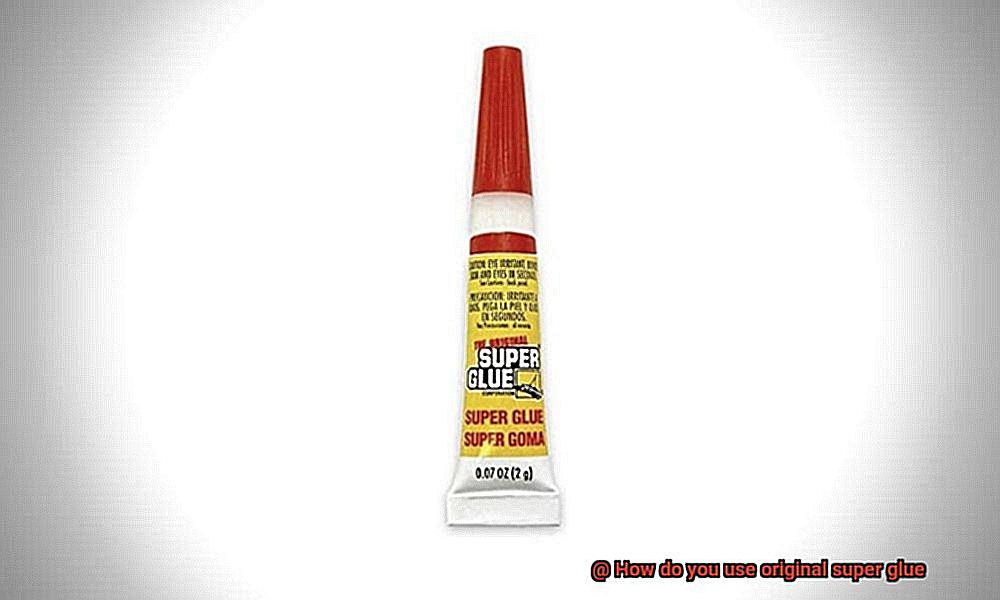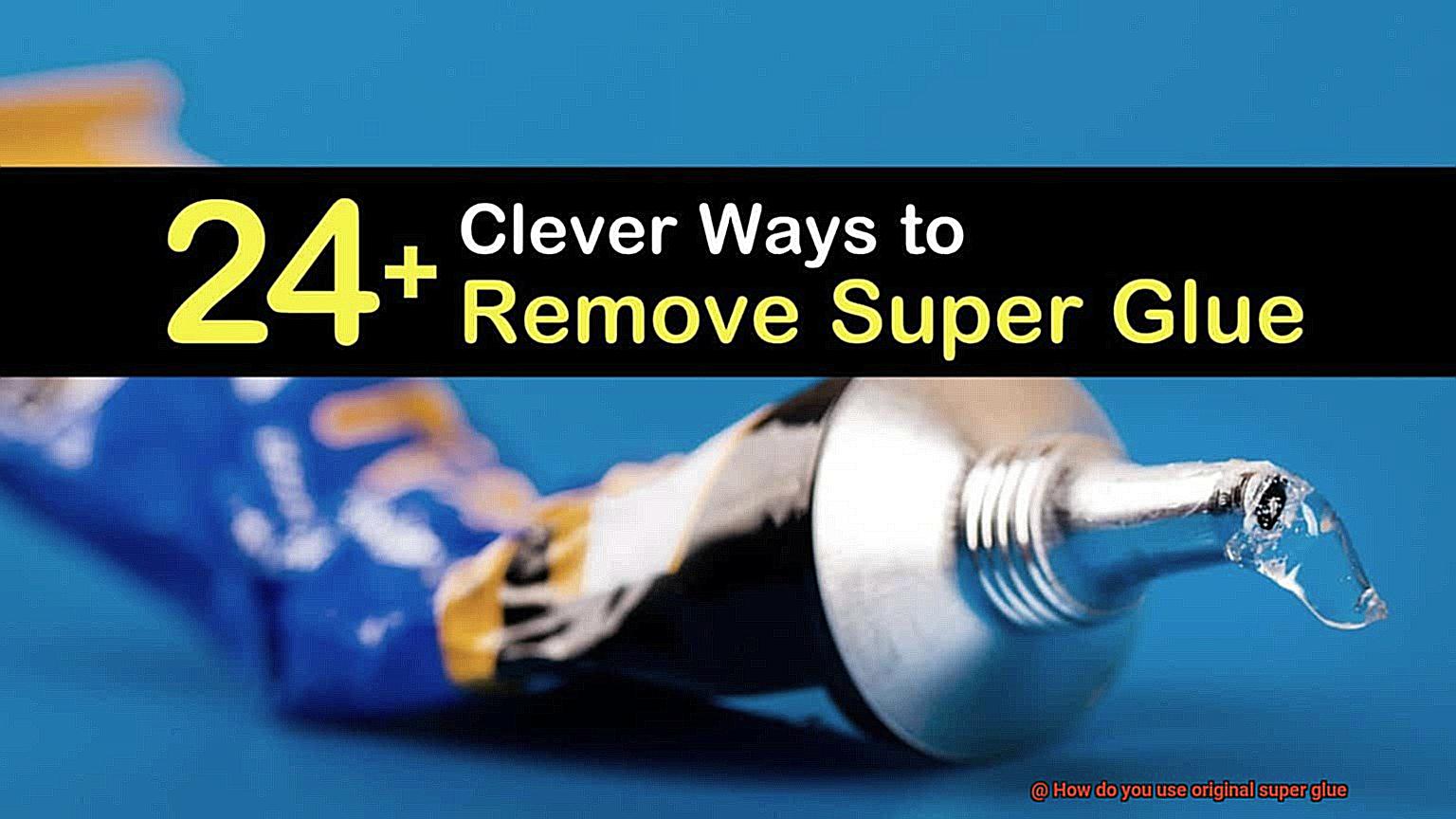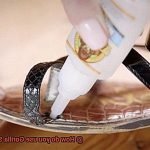Welcome to our blog post about the incredible world of original super glue. Whether you’re a crafty creator, a DIY enthusiast, or just someone in need of a quick fix, super glue is your secret weapon. This adhesive powerhouse can bond almost any material with an unbreakable hold that will leave you amazed.
Using original super glue is as easy as 1-2-First things first, make sure the surfaces you’re bonding are squeaky clean and free from any pesky dust, oil, or moisture. Then, apply a small amount of glue to one surface and press the two together with firm and even pressure. Hold your creation in place for just a few seconds and watch the magic happen – an instant bond that’s tougher than nails.
One of the best things about original super glue is its lightning-fast setting time. In mere seconds, your project will be securely held together, making it perfect for those urgent repairs or projects that can’t wait. From fixing shattered ceramics to rescuing a broken shoe sole from doom, this mighty adhesive has got your back.
But remember, with great power comes great responsibility. Super glue is not to be taken lightly. Avoid getting it on your precious skin or clothing at all costs. If by chance it happens (hey, accidents happen.), gently wash the affected area with warm soapy water. For an extra splatter-resistant experience, try out the gel formula which gives you more control during application.
So, next time you find yourself knee-deep in a craft project or facing a household repair emergency, grab that trusty bottle of original super glue. Its versatility, strength, and lightning-fast setting properties make it the ultimate go-to adhesive for all your bonding needs. Get ready to unleash your creative genius and fix-it superhero powers.
Clean and Prepare the Surfaces
Contents
- 1 Clean and Prepare the Surfaces
- 2 Applying the Glue
- 3 Pressing the Surfaces Together
- 4 Allowing Adequate Time for Bonding
- 5 Removing Accidental Skin Contact with Super Glue
- 6 Storing Original Super Glue Properly
- 7 Benefits of Using Original Super Glue
- 8 Common Mistakes to Avoid When Using Original Super Glue
- 9 Conclusion
When it comes to creating unbreakable bonds, original super glue is the go-to adhesive. But here’s the secret to achieving a bond that stands the test of time: cleaning and preparing the surfaces before application.
In this captivating blog post, we will unlock the reasons why this step is absolutely crucial. Prepare to be amazed as we reveal expert tips on how to clean and prepare surfaces for optimal bonding.
Why Clean and Prepare Surfaces?
- Banishing Contaminants: Before you unleash the power of super glue, it’s vital to banish any trace of dirt, dust, grease, or oil from the surfaces. These sneaky contaminants can sabotage the adhesive properties of the glue, compromising the bond. By meticulously cleaning the surfaces, you create a pristine canvas for the adhesive to adhere to.
- The Adhesion Advantage: Cleaning the surfaces ensures a uniform and silky smooth texture that enhances adhesion. This means a tighter grip between the materials being bonded, resulting in a bond that’s as strong as steel.
- Bye-Bye Residues: Stubborn stains or residues sticking around? Fear not. The right solvent can banish them in a flash. By eliminating these pesky remnants, you eliminate any potential interference with the adhesive properties of super glue.
Tips for Cleaning and Preparing Surfaces:
- The Power of Suds: Arm yourself with mild detergent or soap and water solution to wage war against dirt and grime. Employ a soft cloth or brush and scrub gently until every speck of debris surrenders. Rinse with gusto and let the surfaces dry completely before proceeding.
- Solvent Superheroes: For stubborn stains or residues, unleash the power of an appropriate solvent that plays well with your materials. Follow the manufacturer’s instructions for safe and effective usage.
- Smoothing the Way: Smooth surfaces are key to optimal bonding. Sanding or filing may be necessary to ensure a level playing field. Say goodbye to rough edges and irregularities, and hello to a flawless foundation for a rock-solid bond.
- The Art of Roughening: Sometimes, smooth surfaces need a little rough love. Lightly sand or score them with finesse to enhance adhesion. But tread carefully. Excessive roughening can weaken the very materials you seek to unite.
Applying the Glue
In this guide, we will delve into the secrets of achieving bonds that are as unbreakable as steel. So, put on your gloves and prepare to become a true adhesive expert.
Prepare for Success:
Before embarking on the gluing process, it is vital to lay the groundwork for success. Begin by meticulously cleaning the surfaces that require bonding, ensuring they are free from dirt, grease, and other contaminants. Remember, a pristine surface is the bedrock of a sturdy bond.
Know Your Materials:
Super glue possesses incredible versatility, capable of working wonders on an array of materials such as plastic, metal, wood, and ceramics. Nevertheless, keep in mind that it thrives on clean and smooth surfaces. Should you encounter rough edges or unevenness, consider utilizing sandpaper or a file to achieve a flawlessly smooth foundation before applying the glue.
Special Preparations:
Certain materials may demand additional preparation steps to enhance adhesion and bolster the strength and durability of the bond. For instance, applying a primer or roughening the surface can work wonders. Take the time to research and implement any recommended techniques specific to your chosen materials.
Master the Technique:
To guarantee optimal bonding, follow these simple yet essential steps with precision: First, apply a modest amount of super glue to one surface. Next, firmly press the two surfaces together for a few seconds. This allows the glue to spread evenly and establish a robust initial bond. Remember, patience is key – maintain this pressure until the bond sets.
Prioritize Safety:
While super glue is an extraordinary tool, ensuring safety is paramount when handling it. Consider wearing protective gloves to safeguard your skin and prevent any accidental contact with your eyes. A successful bonding experience is one without mishaps.
Tidying Up:
Applied a tad too much glue? Fear not. Excess glue can be effortlessly removed using acetone or nail polish remover. However, exercise caution to prevent any damage to the bonded surfaces. A touch of precision goes a long way.
Pressing the Surfaces Together
When it comes to using original super glue, one of the most crucial steps for achieving a strong and unbreakable bond is pressing the surfaces together. This simple action can make all the difference between a weak bond that easily breaks and a bond that withstands the test of time.
Before you even think about pressing the surfaces together, it’s important to ensure that they are clean and dry. Any dirt, dust, or moisture on the surfaces can hinder the bonding process and weaken the overall bond. Take a moment to meticulously clean the surfaces using a mild detergent or rubbing alcohol along with a clean cloth. Gently wipe away any dirt or debris, making sure to leave no trace behind. Once cleaned, allow the surfaces to air dry completely before proceeding with the application of the glue.
Now that your surfaces are squeaky clean, it’s time to apply the super glue. Remember, a little goes a long way. Apply a small amount of glue to one of the surfaces. It’s essential not to over-apply, as excess glue can squeeze out and create a messy bond. To ensure an even distribution of glue, use a disposable applicator or a toothpick. Spread the glue evenly over the surface, making sure to cover the entire area that will be bonded.
Once the glue is applied, carefully align the two surfaces and press them together firmly. The act of applying pressure during this step is crucial for achieving a strong bond. Hold the surfaces in place for a few seconds to allow the glue to set. Depending on the size or weight of the objects being bonded, you may need to use clamps or other tools to hold them in place while the glue sets. This additional support ensures that no movement occurs during the curing process.
After pressing the surfaces together, it’s important to avoid moving or disturbing them for at least a few minutes. This allows the glue to fully cure and achieve its maximum strength. Different materials may require different pressing techniques, so be sure to adjust accordingly. For delicate materials like glass or ceramics, apply gentle pressure to avoid breakage. On the other hand, stronger materials like metal or plastic can withstand more pressure.
It’s worth noting that specific super glue products may have slight variations in their application techniques or curing times. Always refer to the manufacturer’s instructions for the best results.
Allowing Adequate Time for Bonding
Achieving a strong and unbreakable bond with original super glue requires one key ingredient: time. Patience truly is a virtue when it comes to bonding, as rushing the process can lead to weak or incomplete bonds that are just waiting to fall apart. So, why is it so crucial to allow adequate time for bonding?
The answer lies in the drying process. Super glue needs time to dry and create a strong bond between the surfaces it’s holding together. While the recommended minimum curing time is 24 hours, factors like temperature and humidity can influence the drying time.
Temperature and humidity play a significant role in the bonding process. Higher temperatures and lower humidity levels can speed up the drying process, while lower temperatures and higher humidity levels can slow it down. If you’re in a hurry and need that bond to set quickly, try applying a bit of heat or reducing the humidity in the room.
However, patience remains paramount. It’s important not to move or disturb the bonded surfaces too soon. Give the glue ample time to fully cure and unleash its maximum strength. Trust me, the wait will be worth it.
To ensure optimal results, always follow the manufacturer’s instructions and recommendations. They know their product best and can provide specific details on application techniques and curing times.
Removing Accidental Skin Contact with Super Glue
Accidental skin contact with super glue can be a frustrating and potentially painful experience. Whether you’re working on a craft project or tackling a DIY repair, it’s important to know how to safely remove super glue from your skin. Here’s a comprehensive guide to help you navigate this sticky situation.
First and foremost, act quickly. As soon as you notice the super glue on your skin, take action. The longer it remains on your skin, the harder it will be to remove. Time is of the essence in this situation.
One effective method to remove super glue from the skin is by using acetone or nail polish remover. These products contain chemicals that can break down the adhesive properties of super glue. Simply apply a small amount of acetone or nail polish remover to a cotton ball or swab and gently rub it over the affected area. It’s important to avoid scrubbing too hard, as this can irritate the skin.
If you don’t have acetone or nail polish remover on hand, warm, soapy water can also be used. Soak the affected area in warm, soapy water for a few minutes to help loosen the super glue. After soaking, gently try to peel off the glue. Patience is key in this process, as it may take several minutes of gentle rubbing or soaking for the super glue to start loosening.
It’s crucial to exercise caution when attempting to remove super glue from the skin. Avoid using sharp objects or abrasive materials, as they can cause injury or damage to the skin. The goal is to safely remove the super glue without causing further harm.
If you’re unable to remove the super glue using these methods or if you experience any discomfort or irritation, it’s best to seek medical advice. A healthcare professional will be able to provide further guidance and assistance in removing the super glue.
Storing Original Super Glue Properly
Properly storing original super glue is crucial to preserving its strength and longevity. To ensure your adhesive superhero doesn’t lose its powers, consider the following tips:
- Find a cool and dry place: Shield your super glue from direct sunlight and extreme temperatures. Aim for room temperature, ideally between 50°F and 77°F (10°C and 25°C). Remember, we want our glue to last as long as possible.
- Use an airtight container: Moisture is not your super glue’s BFF. Store it in an airtight container or bottle to prevent drying out or loss of effectiveness. Keep that adhesive villain at bay.
- Choose a convenient location: Store your super glue in a spot that’s easily accessible and visible. Be the superhero who can swiftly find and retrieve the adhesive when duty calls.
- Clean the nozzle or applicator tip: No clogs allowed. Before storing your glue, ensure the nozzle or applicator tip is free from dried adhesive. This simple step guarantees smooth application in the future and saves you from any frustrating blockages.
- Discard expired or improperly stored glue: If your super glue becomes thick or hardened, it may be time to say goodbye to your old friend. Proper storage is essential, so make sure to replace expired or improperly stored glue with a fresh batch.
- Keep out of reach of children and pets: Let’s avoid any accidental ingestion or misuse. Keep super glue safely stored away from curious hands and paws.
Benefits of Using Original Super Glue
Original super glue is a true superhero among adhesives, offering numerous benefits that set it apart from other types of glues. Whether you’re tackling repairs or working on creative projects, using original super glue can greatly enhance your bonding experience.
One of the most remarkable advantages of original super glue is its fast bonding ability. In the blink of an eye, this adhesive creates a strong bond within seconds. Gone are the days of waiting around for glue to dry, wasting precious time and delaying your progress. With original super glue, you can quickly and efficiently complete your projects and move on to the next task.
Versatility is another key benefit of using original super glue. This adhesive is like a chameleon, capable of bonding almost anything. Whether you’re working with metal, plastic, wood, ceramics, or even rubber, original super glue can handle it all. No matter what materials you’re dealing with, you can trust this adhesive to provide a reliable and long-lasting bond.
Durability is yet another advantage that sets original super glue apart. Once cured, it forms a bond that can withstand high temperatures, moisture, and various environmental conditions. This means that your repairs or creations will stand the test of time, even in challenging situations. You can have peace of mind knowing that your bonds will remain strong and secure.
Convenience is also a notable benefit of using original super glue. It comes in small tubes or bottles with precision applicator tips, making it incredibly easy to use. The compact size allows for easy storage and transportation, while the precision applicator allows for precise and controlled dispensing of the adhesive. Applying original super glue is a breeze, saving you time and hassle.
Chemical resistance is another advantage offered by original super glue. Unlike some adhesives that crumble under the pressure of chemicals and solvents, original super glue stands strong. It is resistant to these substances, making it suitable for applications where exposure to chemicals is expected. You can count on this adhesive to maintain its integrity even in harsh chemical environments.
Additionally, original super glue has the ability to fill gaps or cracks in materials. It goes beyond simply bonding materials together and can also be applied to small crevices or holes, creating a seamless and secure repair. This gap filling ability adds versatility to the adhesive’s functionality, allowing for more versatile applications.
Minimal preparation is another benefit that makes original super glue a go-to choice. Unlike some other adhesives that require clamps and special equipment, this adhesive requires minimal preparation. It can be applied directly to the surface without the need for additional tools, saving you time and effort.
Long shelf life is also a significant advantage of using original super glue. When stored properly, it has a long shelf life, allowing you to keep it on hand for future projects or repairs without worrying about it losing its effectiveness. This means that you can always have a reliable adhesive available whenever you need it.
Common Mistakes to Avoid When Using Original Super Glue
Original super glue is a versatile adhesive that can be used for a wide range of bonding applications. However, using it correctly is crucial to achieve optimal results. In this article, we will explore some common mistakes to avoid when using original super glue and explain why it is important to be aware of them.

Applying too much adhesive:
One of the most frequent mistakes is applying an excessive amount of glue. While it may seem logical to use more glue for a stronger bond, it can actually hinder the effectiveness of the adhesive. Super glue works by reacting with moisture, and applying too much can prevent moisture from reaching the adhesive surface properly. This can result in a weak bond or even failure of the adhesive.
Improper surface preparation:
Properly preparing the surfaces before applying super glue is essential for a strong bond. Surfaces should be clean, dry, and free from any dirt, oil, or debris. Contaminants on the surfaces can hinder the bonding process and result in a weak bond or failure of the adhesive. Taking the time to thoroughly clean and prepare the surfaces will ensure a better and longer-lasting bond.
Insufficient curing time:
Super glue sets quickly, but it takes time for it to reach its maximum strength. Rushing to use or manipulate the glued item before it has fully cured can weaken the bond and lead to potential failure. It is important to allow enough time for the super glue to fully cure according to the manufacturer’s instructions. This will ensure that you achieve the strongest bond possible.
Incompatible materials:
While super glue is known for its strong bonding properties, it may not work well on all materials. Smooth or non-porous surfaces like glass or certain plastics may not adhere well with super glue. It is important to check the compatibility of super glue with the material being bonded and consider using specialized adhesives if necessary. This will prevent wasted time and effort on ineffective bonding attempts.
Improper storage:
Storing super glue improperly can lead to wasted product or reduced effectiveness. Super glue should be stored in a cool and dry place, away from direct sunlight and heat sources. Exposure to extreme temperatures can cause the glue to deteriorate or harden inside the container, rendering it unusable. By storing super glue correctly, you can extend its shelf life and ensure that it remains effective for future use.
47aIPN9iG0o” >
Conclusion
Using original super glue is a straightforward process that requires a few simple steps. First, ensure that the surfaces you plan to bond are clean and dry. This will help the glue adhere properly and create a strong bond.
Next, apply a small amount of super glue to one of the surfaces. Remember, a little goes a long way with this powerful adhesive. Be careful not to use too much, as excess glue can cause messy drips or overspill.
Once you’ve applied the glue, quickly press the two surfaces together firmly. The bond will start to form almost instantly, so it’s essential to align them correctly from the start. Take care not to touch the glued area with your bare hands as this can cause fingerprints or smudges.
Hold the bonded pieces in place for a few seconds to allow the glue to set. You may want to use clamps or other tools to secure larger or heavier objects while they dry. It’s crucial to follow any specific instructions provided by the manufacturer for optimal results.
After allowing sufficient drying time, check that the bond is secure before moving or using the glued item. Original super glue typically dries clear and creates an incredibly strong hold that can withstand various conditions.
Remember, safety is paramount when working with any adhesive. Always read and follow the safety instructions on the product packaging and work in a well-ventilated area.
In conclusion, using original super glue involves cleaning and preparing surfaces, applying a small amount of glue, pressing them together firmly, allowing proper drying time, and ensuring safety precautions are followed.






